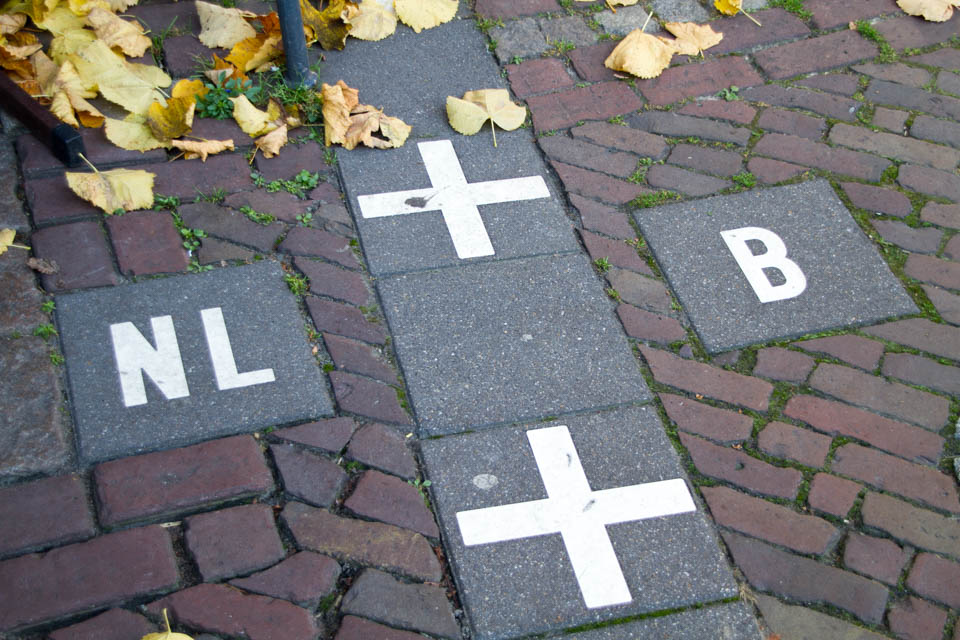
Date of visit: 29 October 2015, weather: sunny
The goal is to get to the delightful Dutch & Belgian enclave « Baarle Nassau » = « Baarle Hertjo ».
以前書きましたとおり、今回の旅のメインテーマのひとつは「飛び地」巡り。この日はその第二弾。オランダの中にあるベルギー、いやさらにその中にあるオランダー??とにかく一つの街に幾つもの飛び地があるという世界でも大変めずらしい街「バールレ・ナッサウ(オランダ部分の呼び方)」=「バールレ・ヘルトホ(ベルギー部分の呼び方)」です。
The map shows it clearly, this is what it looks like.
Around it is the Netherlands, but inside the grey line is Belgium. However, within that line is also the Netherlands.
This complicated and mysterious enclave came into being in 1198. Until then, the lord of Breda, which belonged to the Netherlands, ruled this « Baarle », but due to some troubles related to his ancestors, he gave Baarle to the Duke of Brabant, and the Duke of Brabant gave the land back to the King of Breda little by little in the form of a loan.
ところが、このブラバン公、諸事情があったにせよ、まとまった土地、つながった土地を返せばよいものの、飛び飛びの小さい土地を少しずつ返していったため、ブレダ王に戻った土地とブラバン公がまだ所有している土地がモザイク状に入り組んでしまったのです。
The lands of the King of Breda then passed to the House of Nassau, who called them « Barre Nassau » and « Barre Hertojo » (Duchy of Barre) respectively.
However, both were still under the rule of the Holy Roman Empire and only had different lords, but the Treaty of Westphalia in 1648 (*If you’re in the World History cluster, you’ll know this because it’s on the test! However, when the Netherlands officially gained independence from Spain in the Treaty of Westphalia in 1648, Belgium, which had a strong Catholic influence, remained in Spanish territory, and the village of Baarle was divided between the territories of the two nations.
Afterwards, Olander and Belgium negotiated to dissolve the enclaves because of the inconvenience of such mosaic-like enclaves, but in the end, they failed due to religious reasons (Belgium is Catholic and the Netherlands is Protestant). The city is still full of mosaic-like enclaves today.
However, it seems that the current residents do not want the enclave to be dissolved. Rather, it is because they think that this complexity can be used in the opposite direction. One of the main reasons for this is that it will give the city a great tourist appeal. In fact, however, the city has a dark past, having been used for smuggling and money laundering in the past.
吉田一郎、世界飛び地大全 (角川ソフィア文庫)より
Entering the Netherlands and Belgium to get to the destination.
From Aachen, where there is a small cathedral, we went to the city full of such enclaves. First of all, we took the autobahn into the Netherlands, and after about an hour of driving in the Netherlands, we entered the Belgian territory. We got off the autobahn at this point and took the open road to the Dutch border and entered the Netherlands again.

In the first place, this area is a junction of the Dutch and Belgian borders, if not an enclave.
そして、オランダ国境を超えて5分程度で目的地バールレ・ナッソーに到着しました。街の南側からの到着です。まずは駐車場を見つけるため街の中心を目指しましたが、すでに街に入った時点で、ベルギーに入ったりオランダに入ったりしていたようです。

なんでわかったかというと、ガソリンスタンドが100mもしない距離で2件あったのですが、明らかに値段が違うからです。(運転中につき写真撮れず…、MT車ですから。)ちなみにベルギーのほうが安いようです。オランダはドイツと同程度。税金の関係なのでしょう。オランダ領のスタンド、商売できるの??
Well, I found a public parking lot around the center of town anyway, so I parked my car there and started sightseeing. The parking lot was unknown whether it was paid or free, but there is no parking meter, so I parked as it is.

I don’t have any information, so I’ll just take a stroll.
I wanted to start sightseeing, but to be honest, I didn’t have any information about this place other than it was an enclave, and I couldn’t use the rental mobile WiFi I was relying on because it was out of range and I couldn’t check anything. So, I decided to walk around the city at random. There are some customers in the cafe in the center of town. I wonder if they are locals or tourists?

However, as soon as we started walking, we found a complicated border. Is this the rumored border line (laughs)?

The border line also continues on the road. The speed limit on city streets is 50 km/h, so there is no need to change your speed. (It used to be 60km in the Netherlands and 50km in Belgium.

しかし、道路の上といった「外」で国境があるのは普通といえば普通。ところがこの街は、やっぱり他となんか違う。例えば、これはとあるお店の入り口の写真ですが、お店の入り口まではベルギー領ですが、お店の中はオランダ領なのです。

そしてまた別の例ではこちら。同じマンションですが、右からはベルギーからの訪問、左からはオランダからの訪問ってことですかね(笑)。ドアのすぐ裏はつながっているのに。ちなみに中はオランダ領みたいです。

To distinguish which country a house belongs to, national flags are put on the doorplates and doors.

After exploring the city for a while, we found a tourist information center. However, it was closed. Too bad. This place was on the Dutch side.

In another section, there is a city hall. This is a section for the Belgian side, because the Belgian flag was displayed here. Is there a city hall for the Netherlands on the Dutch side?

This is how we strolled around what we thought was the center of the city for about 30 minutes. We could have done a bit more sightseeing if the mobile WiFi signal was working, or if the tourist information center was open.

However, it was very interesting. To be honest, it’s a rural town with bad traffic and no attractions nearby, but it was a great decision to visit. It became a very good memory.
まだもう少し時間があるので、もう一件観光してから本日のホテルに向かうことにします。(続く)


